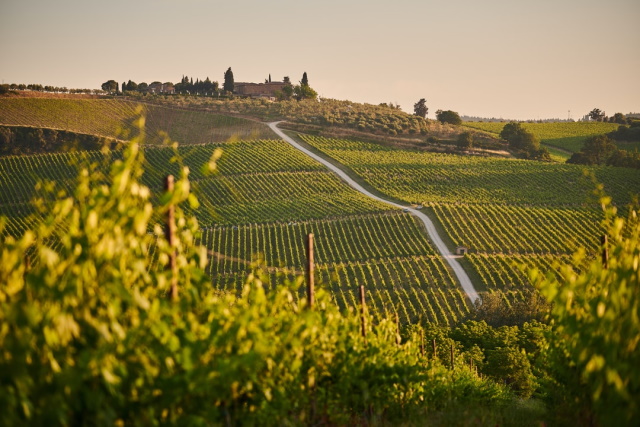
Italy is the top wine-producing country in the world. While it features many notable wines and wine-growing regions, Tuscany certainly stands among the best.
Some of the most famous wines in the world are Tuscan, like Chianti, a dry, red wine produced in one particular part of the region. Others include Brunello di Montalcino, Vino Nobile di Montepulciano, and a group of wines called Super Tuscans. Here, we’ve got your guide to the latter, including popular brands, delicious food pairings, and tips for selecting the best varieties.
What Makes Tuscan Wines So Great?
One of the most significant factors in Tuscany’s success is the region’s climate. It features warm coastal areas and cooler inland temperatures, where direct sunlight and significant diurnal temperature shifts create optimal grape growing conditions. Those temperature variations give the grapes a balance of ripeness and acidity.
Tuscan wines also have a long history, which may play a part in their popularity. Several sources say wine-making began in the 8th century BC with the Etruscans. The grapevines thrived throughout the centuries, nurtured by the Romans, medieval monks, and renaissance aristocracy. While the region’s most famous wine, Chianti, received a reputation for being a cheap wine in the years after World War II, modern winemakers have rejuvenated its legacy and are now producing some of today’s highest-quality wines.
The region’s most well-known grape, Sangiovese, thrives in the inland hillside vineyards. The rich soil and high number of vintners result in Sangiovese wines with very different terroirs. But other varieties flourish here as well.
The Making of Tuscan Wine
Tuscany introduced the Denominazione di Origine Controllata (DOC) in the 1960s, which put strict regulations on the production of Chianti wine. In the 1980s, Tuscany saw the introduction of the Denominazione di Origine Controllata e Garantita (DOCG). In addition to following the rules set forth for DOC wines, a DOCG wine also needs to undergo an analysis and panel tasting to guarantee its merit.
Beginning in the 1970s, some winemakers in the Chianti region of Tuscany felt the requirements for DOC (and later, DOCG) wines were not strict enough and allowed for lower-quality products. These regulations also prevented experimentation, like the creation of 100% Sangiovese wines. A few producers decided to experiment anyway, resulting in the creation of Super Tuscan wines. Many Super Tuscan blends include international grape varieties (including Cabernet Sauvignon and Merlot). Others are mostly, if not entirely, Italian grapes. The differences mostly come from the aging and blending.
In 1992, Tuscany created the Indicazione Geografica Tipica (IGT). Wines labeled under this designation don’t have to meet the strict requirements necessary for receiving a DOC or DOCG label. This gave winemakers greater flexibility in terms of grape selection and production methods. Today, many Super Tuscan wines use the IGT designation.
Winemaking processes for Tuscan wines vary. Each DOC in Tuscany has its own regulations regarding permitted grape varieties and aging requirements. Winemakers who want a DOC or DOCG designation need to follow those rules to receive it. On the other hand, Super Tuscan wine producers have much more freedom in what grapes they use, how long they age their wines, and the type of barrels they use.
Popular Super Tuscan Brands
There are many great wines on the market today, but here are a few that we think are worthy of your consideration:
Tenuta San Guido Sassicaia
Many consider Sassicaia the first Super Tuscan wine. A blend of 85% Cabernet Sauvignon and 15% Cabernet Franc, it’s a medium to full-bodied wine with notes of berry and chocolate.
Antinori Tignanello
Another original Super Tuscan wine, Tignanello is a blend of Sangiovese, Cabernet Sauvignon, and Cabernet Franc. While it’s usually 80% Sangiovese, the exact percentages vary by vintage. The wine features notes of cherry, rose, minerals, and spices.
Fontodi Flaccianello della Pieve
This Super Tuscan wine is 100% Sangiovese that ages in oak barrels for a full 24 months. Flavor notes include black currant, herbs, mushrooms, and berries.
Food Pairings to Try with Super Tuscan Wines
While you could enjoy them on their own, Tuscan wines also pair perfectly with meals. Following the general rules of wine and food pairing, you’ll generally want to match bold with bold. The variety of Tuscan wine blends also means they can work with a wide range of foods.
Many Super Tuscan wines are acidic, making them an ideal companion for salty, fatty foods. If you’re looking to pair a Super Tuscan with an appetizer, consider foie gras or an antipasto platter of rich meats and aged cheeses. These appetizers stand up well to the flavors of the fuller-bodied wines.
Tuscan wines work well with vegetable and slow-simmered pasta dishes with deeper, more complex flavors. Consider a mushroom lasagna with tomato sauce and Parmesan cheese or a creamy polenta. Grilled pork with herbs, Osso Bucco, veal parmesan, and meat-based pizzas also make excellent pairings.
Generally speaking, the bolder flavors of these wines will overpower fish dishes. However, if you love seafood, a dish of swordfish with garlic and capers makes a good companion for the wine.
Explore Tuscany Through Its Delicious Wines
Italy is renowned for its wines. The country is home to 20 unique wine regions, and Tuscany is arguably the most famous. While Chianti may be the region’s most well-known wine, the world of Tuscan wine is vast. There’s a lot to explore and a lot to love.
Are you ready to begin your Tuscan wine journey? With a wide variety of wines from the most popular region in Italy, JJ Buckley Fine Wines has a bottle to fit your tastes. Visit our website to start your exploration today.